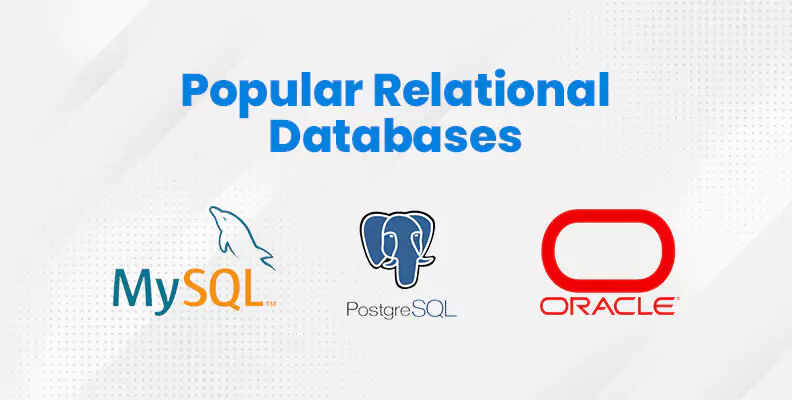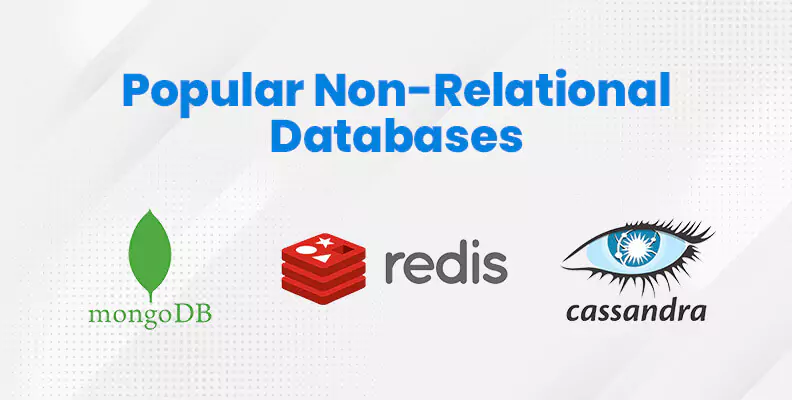Loading.....
Relational vs. Non-Relational Databases

In the world of data management, databases play a crucial role in handling information effectively. When it comes to comparing databases, two main types often stand out: relational and non-relational databases. These two types serve the fundamental purpose of data storage, they operate on different principles and cater to distinct use cases. Let's dive into this blog to gain a better understanding of these two types of databases.
Relational Databases

Relational databases adhere to the principles of relational model theory, which was introduced by Edgar F. Codd in the 1970s. These databases are structured around tables consisting of rows and columns. Each table represents an entity, and the connections between entities are established via keys. The Structured Query Language (SQL) is commonly used to interact with relational databases, facilitating operations such as querying, insertion, deletion, and updating of data.
Key Characteristics of Relational Databases
- Structured Schema: Relational databases enforce a predetermined schema that defines the structure of data stored in tables. This schema includes the data types, constraints, and relationships between tables, ensuring data integrity and consistency.
- ACID Compliance: Relational databases adhere to the ACID (Atomicity, Consistency, Isolation, Durability) properties, which guarantee transactional reliability. ACID compliance ensures that database transactions are executed reliably and consistently, even in the event of system failures or concurrent access.
- Normalized Data: Relational databases commonly utilize normalization techniques to reduce redundancy and dependency in storing data. Normalization involves organizing data into multiple related tables to reduce data duplication and improve data integrity.
- Complex Queries: Relational databases excel in handling complex queries involving multiple tables and intricate relationships. SQL provides powerful capabilities for data manipulation, aggregation, and retrieval, making it suitable for diverse applications ranging from business analytics to transaction processing.
Non-Relational Databases

Non-relational databases, also known as NoSQL (Not Only SQL) databases, emerged as an alternative to relational databases to address the limitations of scalability, flexibility, and performance in certain use cases. Unlike relational databases, which adhere to a rigid schema, non-relational databases offer more flexibility in data modeling and storage. NoSQL databases employ various data models, including document-oriented, key-value, columnar, and graph-based, catering to diverse application requirements.
Key Characteristics of Non-Relational Databases
- Schema Flexibility: Non-relational databases embrace schema flexibility, allowing developers to store unstructured or semi-structured data without predefined schemas. This flexibility simplifies data modeling and accommodates evolving data requirements in dynamic environments.
- Horizontal Scalability: Non-relational databases are designed for horizontal scalability, enabling them to distribute data across multiple nodes or clusters seamlessly. Horizontal scaling facilitates high availability, fault tolerance, and elastic scalability, making NoSQL databases well-suited for large-scale distributed systems and cloud environments.
- High Performance: Non-relational databases prioritize performance and scalability by employing efficient data storage and retrieval mechanisms. With optimized data structures and distributed architectures, NoSQL databases deliver low-latency responses and handle high throughput effectively, making them suitable for real-time analytics, content management, and IoT applications.
- Eventual Consistency: Unlike the strong consistency model of relational databases, non-relational databases often adopt eventual consistency, where data consistency is guaranteed over time but may exhibit temporary inconsistencies during concurrent updates. Eventual consistency enables high availability and partition tolerance in distributed systems, accommodating trade-offs between consistency, availability, and partition tolerance (CAP theorem).
Relational Databases v/s Non-Relational Databases
Relational Databases: Ideal for structured data with well-defined relationships, complex queries, and applications requiring ACID compliance.
- Structured Data: Relational databases excel in managing structured data with predefined schemas. If your application relies heavily on data consistency and requires complex querying capabilities, a relational database is a suitable choice.
- Transactions: Applications that demand transaction support, such as banking systems or e-commerce platforms, benefit from the transactional integrity provided by relational databases. ACID compliance ensures that transactions are reliably processed and committed.
- Scalability: Although relational databases can vertically scale by adding additional resources to a single server, horizontally scaling across multiple servers can present challenges.. However, modern relational databases offer features like sharding and replication to address scalability concerns to some extent.
Non-Relational Databases: Suitable for dynamic schemas, scalability, high availability, and specialized data models beyond the tabular structure.
- Big Data and Real-time Analytics: Non-relational databases shine in scenarios where massive amounts of data need to be processed quickly, such as real-time analytics, IoT applications, and social media platforms. Their distributed architecture allows for seamless scaling across clusters of servers.
- Flexible Schema: Applications dealing with evolving or unpredictable data schemas benefit from the flexibility offered by non-relational databases. Developers can store and retrieve data without adhering to a strict schema, facilitating rapid application development and iteration.
- High Availability and Fault Tolerance: Non-relational databases are designed for high availability and fault tolerance. They often employ replication and automatic failover mechanisms to ensure continuous operation, making them suitable for mission-critical applications that cannot afford downtime.
Conclusion: Choosing the Right Database for Your Needs
Choosing between relational and non-relational databases depends on the specific needs of your project. Relational databases are best for scenarios prioritizing data integrity and complex querying, while non-relational databases offer flexibility and scalability for dynamic environments. By understanding the differences between these two types of databases and evaluating your project's needs, you can make an informed decision that aligns with your goals and objectives. Whether you opt for the structured simplicity of relational databases or the flexible scalability of non-relational databases, both offer powerful solutions to meet the demands of modern application development.
 Back to blog
Back to blog












